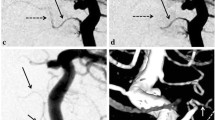Abstract
Purpose
To describe a case of a medial-type persistent trigeminal artery (PTA) associated with multiple arterial variations.
Methods
A 34-year-old woman with multiple sclerosis underwent cranial magnetic resonance (MR) angiography from the aortic arch to the neck region and intracranial region for the evaluation of an unruptured cerebral aneurysm that was previously detected on MR imaging. The MR machine was a 3-T scanner.
Results
There was an aberrant right subclavian artery and bicarotid trunk, medial-type left PTA and ipsilateral posterior communicating artery (PCoA) supplying bilateral posterior cerebral arteries (PCAs). The unruptured aneurysm was located at the paraclinoid segment of the left internal carotid artery and was treated successfully by coil embolization via a transfemoral approach.
Conclusion
Only 10% of PTAs are classified as the medial type. The association with extremely large ipsilateral PCoA, which supplies the bilateral PCAs, has not been previously reported. Aberrant right subclavian arteries are common and are frequently associated with a bicarotid trunk. Before catheterization of the cerebral arteries, the aortic arch and its branches must be evaluated by MR angiography or computed tomography angiography to prevent catheterization failure via the right transradial approach.




Similar content being viewed by others
Data availability
Not applicable.
References
Deniz MA, Turmak M, Hattapoğlu S, Tekinhatun M (2022) Persistent trigeminal artery detected on computed tomography angiography. Surg Radiol Anat 44:715–720. https://doi.org/10.1007/s00276-022-02960-5
Huang W, Zhang Y, Zhuang Y, Shi Y, Feng Y (2023) An anatomical study of persistent trigeminal artery detected by computed tomography angiography and magnetic resonance angiography: proposal for a modified classification and a novel basilar artery grading system. Surg Radiol Anat 45:947–957. https://doi.org/10.1007/s00276-023-03164-1
Mrochek AG, Kabak SL, Haidzel IK, Melnichenko YM, Kalenchic TI (2019) Coexistence an aberrant right subclavian artery with other congenital anomalies: case report and review of the literature. Surg Radiol Anat 41:963–967. https://doi.org/10.1007/s00276-019-02206-x
Natsis K, Didagelos M, Gkiouliava A, Lazaridis N, Vyzas V, Piagkou M (2017) The aberrant right subclavian artery: cadaveric study and literature review. Surg Radiol Anat 39:559–565. https://doi.org/10.1007/s00276-016-1796-5
O’uchi E, O’uchi T (2010) Persistent primitive trigeminal arteries (PTA) and its variant (PTAV): analysis of 103 cases detected in 16,415 cases of MRA over 3 years. Neuroradiology 52:1111–1119. https://doi.org/10.1007/s00234-010-0669-6
Polguj M, Chrzanowski Ł, Kasprzak JD, Stefańczyk L, Topol M, Majos A (2014) The aberrant right subclavian artery (arteria lusoria): the morphological and clinical aspects of one of the most important variations—a systematic study of 141 reports. ScientificWorldJournal 2014:292734. https://doi.org/10.1155/2014/292734
Salas E, Ziyal IM, Sekhar LN, Wright DC (1998) Persistent trigeminal artery: an anatomic study. Neurosurgery 43:557–561. https://doi.org/10.1097/00006123-199809000-00082. (discussion 561–562)
Saltzman GF (1959) Patent primitive trigeminal artery studied by cerebral angiography. Acta Radiol 51:329–336. https://doi.org/10.3109/00016925909171103
Tasdemir R, Yasin S, Cihan OF (2023) Basilar artery formed by persistent primitive trigeminal artery: a case report. Surg Radiol Anat 45:333–335. https://doi.org/10.1007/s00276-023-03096-w
Uchino A (2019) Carotid-vertebrobasilar anastomosis: magnetic resonance and computed tomographic angiographic demonstration. Jpn J Radiol 37:565–578. https://doi.org/10.1007/s11604-019-00847-x
Uchino A, Saito N, Okada Y, Kozawa E, Mizukoshi W, Inoue K, Takahashi M (2012) Persistent trigeminal artery and its variants on MR angiography. Surg Radiol Anat 34:271–276. https://doi.org/10.1007/s00276-011-0848-0
Uchino A, Saito N, Okada Y, Kozawa E, Nishi N, Mizukoshi W, Nakajima R, Takahashi M, Watanabe Y (2013) Variation of the origin of the left common carotid artery diagnosed by CT angiography. Surg Radiol Anat 35:339–342. https://doi.org/10.1007/s00276-012-1038-4
Weon YC, Choi SH, Hwang JC, Shin SH, Kwon WJ, Kang BS (2011) Classification of persistent primitive trigeminal artery (PPTA): a reconsideration based on MRA. Acta Radiol 52:1043–1051. https://doi.org/10.1258/ar.2011.110191
Funding
The authors did not receive support from any organization for the submitted work.
Author information
Authors and Affiliations
Contributions
AU carried out the study design and drafted the manuscript. AU and RK reviewed the manuscript critically, and have read and approved the final manuscript.
Corresponding author
Ethics declarations
Conflict of interest
The authors declare no competing interests.
Ethical approval and consent to participate
All procedures performed in studies involving human participants were in accordance with the ethical standards of the institutional and/or national research committee and with the 1964 Helsinki Declaration and its later amendments or comparable ethical standards.
Consent for publication
The patient signed informed consent regarding publishing her data and figures.
Additional information
Publisher's Note
Springer Nature remains neutral with regard to jurisdictional claims in published maps and institutional affiliations.
Rights and permissions
Springer Nature or its licensor (e.g. a society or other partner) holds exclusive rights to this article under a publishing agreement with the author(s) or other rightsholder(s); author self-archiving of the accepted manuscript version of this article is solely governed by the terms of such publishing agreement and applicable law.
About this article
Cite this article
Uchino, A., Kondo, R. Medial-type persistent trigeminal artery and ipsilateral posterior communicating artery supplying bilateral posterior cerebral arteries combined with an aberrant right subclavian artery and bicarotid trunk. Surg Radiol Anat 45, 1557–1561 (2023). https://doi.org/10.1007/s00276-023-03247-z
Received:
Accepted:
Published:
Issue Date:
DOI: https://doi.org/10.1007/s00276-023-03247-z




